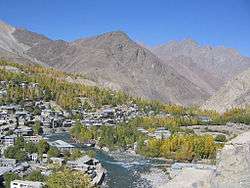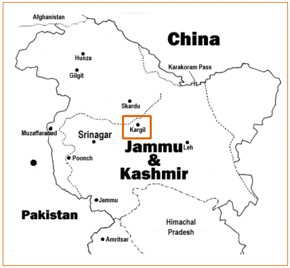Kargil
Kargil is a town in Kargil district and the joint capital of the Indian Union territory of Ladakh.[3] Kargil is the second largest town in Ladakh after Leh.[4] It is located 204 km to the east of Srinagar and 234 km west of Leh to the east. Kargil is the centre of the Suru River valley, historically known as Purig.
Kargil | |
|---|---|
Town | |
 Kargil | |
| Coordinates: 34°33′N 76°08′E | |
| Country | |
| Union territory | Ladakh |
| District | Kargil |
| Government | |
| • Type | Ladakh Autonomous Hill Development Council, Kargil |
| Area | |
| • Total | 2.14 km2 (0.83 sq mi) |
| Elevation | 2,676 m (8,780 ft) |
| Population (2011)[1] | |
| • Total | 16,338 |
| Others | |
| Time zone | UTC+5:30 ([Indian Standard Time) |
| Vehicle registration | LA 02 |
| Official languages | Purki[2] |
| Other spoken | Shina Balti Urdu |
| Website | kargil |
Etymology
The name Kargil is said to derive from the words Khar, meaning castle, and rKil meaning "centre". "Kargil denotes a place between many forts, a central place where people could stay". It appears to be a fitting description for a place that is equidistant from Srinagar, Leh and Skardu (the capitals of the Kashmir Valley, Ladakh and Baltistan respectively).[5]
Historically, the region around Kargil was called Purig.[6] A major study of the history of Purig is included in the 1987 book Qadeem Ladakh by Kacho Sikander Khan, which includes genealogies of various dynasties that ruled the region.[7]
History
Kargil is the main town in the historical region of Purig, which consists of the Suru river basin. It was not the historical capital of the region. Earlier, Purig consisted of a number of small but independent kingdoms, which included Pashkum, Chiktan, Fokar, Soth and the Suru Valley. These tiny principalities would often fight among themselves over petty issues. Gasho “Thatha Khan”, an exiled prince in the 9th century AD, is perhaps the first ruler who brought together all the territories under a united administration. Another sultan of Purig extended his kingdom to include Zanskar, Sot, Barsoo, Sankoo pretty much the territory of the present Kargil district. He is referred to as “The Purig Sultan”. His capital was based at Karpokhar in the Suru Valley. The other famous kings of Kargil were Boti Khan, Abdal Khan, Amrood Choo, Tsering Malik, Kunchok Sherab Stan and Thi Sultan.
It is said that it was the period of Ali Sher Khan Anchan, the famous ruler of Skardu, in the late 16th and early 17th centuries which had a great influence on the area. This prince from Baltistan conquered most of the principalities of Purig and introduced Balti culture in the Kargil district. Subsequently, it was the Dogras who united Baltistan, Purig, Zanskar and present-day Leh district in the first half of the 19th century under a single administrative unit, which lasted until 1947 when a new line of control was demarcated between India and Pakistan separating Skardu and Kargil.[8]


Before the Partition of India in 1947, Kargil was part of the wazarat (district) of Ladakh, a sparsely populated region with diverse linguistic, ethnic and religious groups, living in isolated valleys separated by some of the world's highest mountains. The Ladakh wazarat had three tehsils (sub-districts), named after the cities of their headquarters: Leh, Skardu and Kargil. The district headquarters shifted between the three locations each year.[9]
The First Kashmir War (1947–48) concluded with a ceasefire line that divided the Ladakh wazarat, putting roughly the Kargil and Leh tehsils on the Indian side, and the Skardu tehsil on the Pakistan side. The two Indian tehsils were soon promoted to districts and Ladakh was named a Division, on par with the Jammu and Kashmir Divisions in the Indian state of Jammu and Kashmir. Pakistan renamed the Skardu tehsil Baltistan and divided it into further districts.
At the end of Indo-Pakistani War of 1971, the two nations signed the Simla Agreement, converting the former ceasefire line with some adjustments into a Line of Control, and promising not to engage in armed conflict with respect to that boundary.[10]
In 1999 the area saw infiltration by Pakistani forces, leading to the Kargil War. Fighting occurred along a 160 km long stretch of ridges overlooking the only road linking Srinagar and Leh.[11] The military outposts on the ridges above the highway were generally around 5,000 metres (16,000 ft) high, with a few as high as 5,485 metres (18,000 ft). After several months of fighting and diplomatic activity, the Pakistani forces were forced to withdraw to their side of the Line of Control by their Prime minister Nawaz Sharif after his visit to the USA.[12]
Geography

Kargil has an average elevation of 2,676 metres (8,780 feet), and is situated along the banks of the Suru River (Indus). The town of Kargil is located 205 km (127 mi) from Srinagar,[13] facing the Northern Areas across the LOC. Like other areas in the Himalayas, Kargil has a temperate climate. Summers are hot with cool nights, while winters are long and chilly with temperatures often dropping below −20 °C (−4 °F).[14]
Demographics
During 2011 census, the population of Kargil town was recorded at 16,338. A majority of the population (11,496) is classified as Scheduled Tribes. The literacy rate is 75%.[1]
Transport
An Indian national highway (NH 1D) connecting Srinagar to Leh cuts through Kargil, as well as an airport.
A famous all-weather road, the Kargil-Skardu road linked Kargil with Skardu, a city in Gilgit-Baltistan. Since the 1948 Kashmir War, the road has been closed. Whilst the Indian Government has been interested in opening the road as a humanitarian gesture, this has been refused by the Pakistani Government.[15][16][17]
See also
References
- District Census Handbook: Kargil, Directorate of Census Operations, 2011, pp. 22–23
- "Report of the Commissioner for linguistic minorities: 50th report (July 2012 to June 2013)" (PDF). Commissioner for Linguistic Minorities, Ministry of Minority Affairs, Government of India. p. 49. Archived from the original (PDF) on 8 July 2016. Retrieved 14 January 2015.
- Ladakh to have headquarters both at Leh and Kargil, Greater Kashmir, 16 February 2019.
- Osada et al (2000), p. 298.
- Radhika Gupta, Allegiance and Alienation (2013), p. 49.
- Grist, Urbanisation in Kargil 2008, p. 80.
- Kalla, Krishan Lal (1997). Kashmir Panorama. Raj Publications. ISBN 978-81-86208-07-6.
- Ismail Khan (4 September 2005). "A peaceful Kargil". Dawn. Archived from the original on 13 October 2008.
- Aggarwal, Beyond Lines of Control 2004, p. 35.
- Cheema, Pervaiz Iqbal (2003). The Armed Forces of Pakistan. Allen & Unwin. ISBN 1-86508-119-1. Pg 4
- "1999 Kargil Conflict". GlobalSecurity.org. Retrieved 20 May 2009.
- "War in Kargil - The CCC's summary on the war" (PDF). Archived from the original (PDF) on 27 March 2009. Retrieved 20 May 2009.
- Profile of Kargil District Archived 18 May 2009 at the Wayback Machine Official website of Kargil District
- "Climate & Soil conditions". Official website of Kargil District. Archived from the original on 10 April 2009. Retrieved 20 May 2009.
- "Moving on the Kargil-Skardu road". Indian Express. 24 April 2007. Retrieved 22 April 2013.
- "The Kargil-Skardu Route: Implications of its Opening by Zainab Akhter". Ipcs.org. Retrieved 22 April 2013.
- "Q. 368 Present status of Kargil to Skardu Road | Institute for Defence Studies and Analyses". Idsa.in. 29 March 2012. Retrieved 22 April 2013.
Bibliography
- Aggarwal, Ravina (2004), Beyond Lines of Control: Performance and Politics on the Disputed Borders of Ladakh, India, Duke University Press, ISBN 0-8223-3414-3
- Gupta, Radhika (2013). "Allegiance and Alienation: Border Dynamics in Kargil". In David N. Gellner (ed.). Borderland Lives in Northern South Asia. Duke University Press. pp. 47–71. ISBN 978-0-8223-7730-6.
- Huttenback, Robert A. (1961), "Gulab Singh and the Creation of the Dogra State of Jammu, Kashmir, and Ladakh" (PDF), The Journal of Asian Studies, 20 (4): 477–488, doi:10.2307/2049956
- Karim, Maj Gen Afsir (2013), Kashmir The Troubled Frontiers, Lancer Publishers LLC, pp. 30–, ISBN 978-1-935501-76-3
- Panikkar, K. M. (1930), Gulab Singh, London: Martin Hopkinson Ltd
Further reading
- Hussain, Javed (21 October 2006). "Kargil: what might have happened". Dawn. Archived from the original on 2 December 2008. Retrieved 20 May 2009.
- Yukiyasu Osada; Gavin Allwright; Atsushi Kanamaru (2000), Mapping the Tibetan World, Tokyo: Kotan Publishing (published 2004), ISBN 0-9701716-0-9
- Paul Beersmans (13 June 1998), Jammu and Kashmir State 1998, Belgian Association for Solidarity with Jammu and Kashmir, archived from the original on 6 October 2007